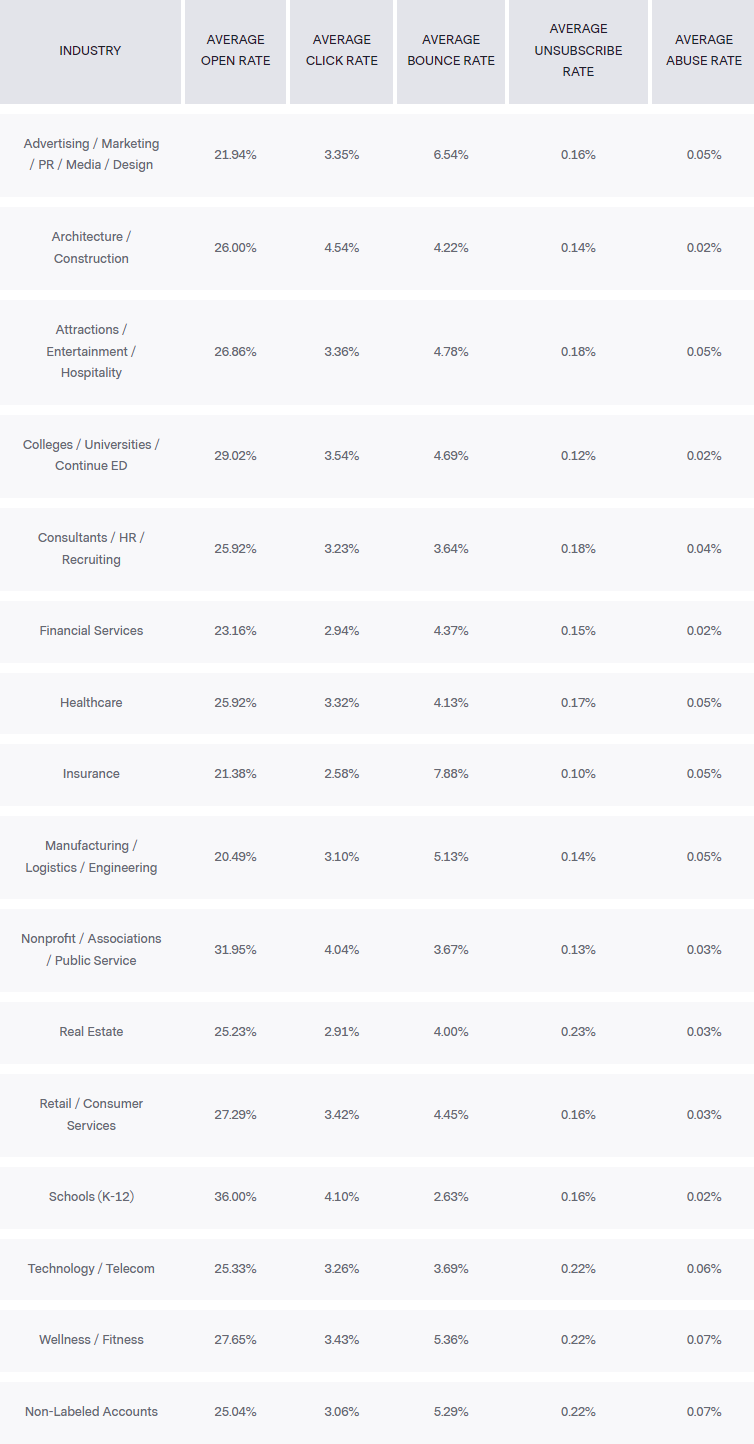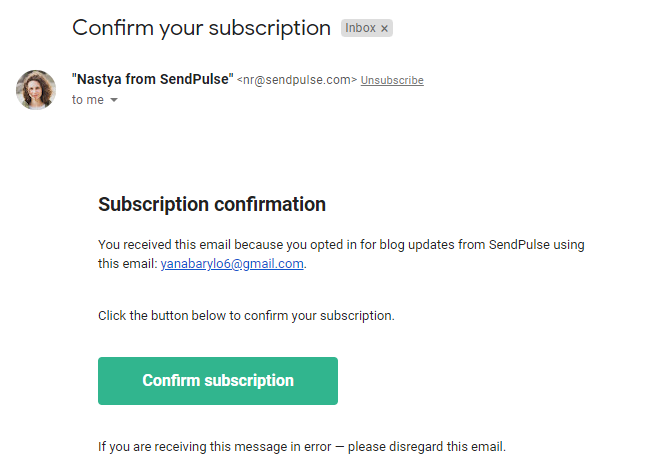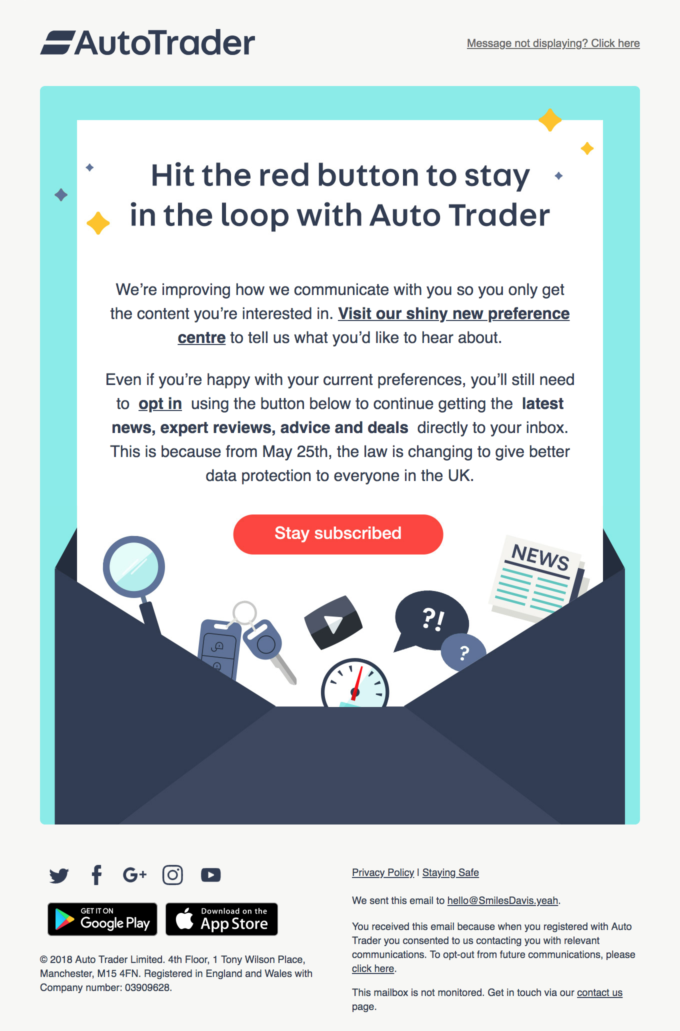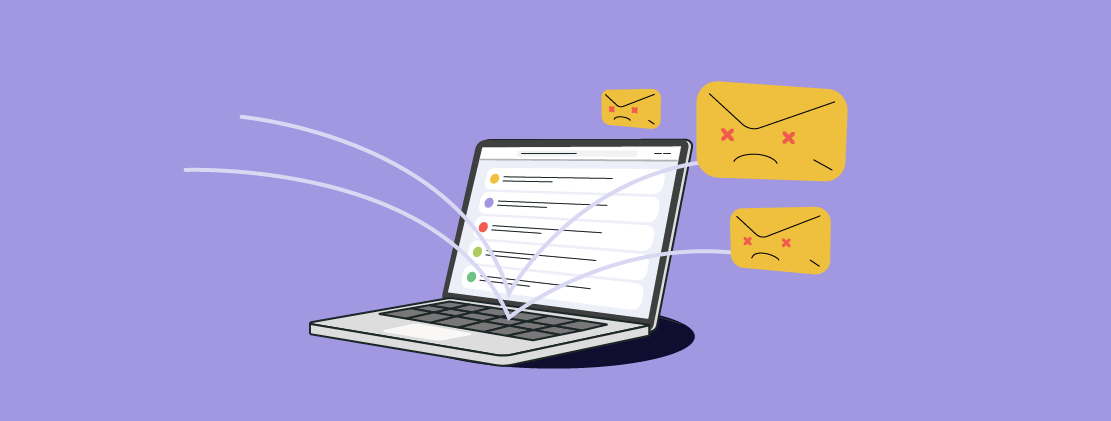We need to talk about bounces. Why are they the way that they are? Honestly, every time you try to do something fun or exciting, bounce backs make it not that way.
It’s frustrating, infuriating, nerve-wracking, but not unsolvable. Although bounce back emails can harm your sender reputation and deliverability, this issue is far from new. In this post, we will help you do some catching up on how to categorize your bounce backs, why your emails bounce, and how to prevent it from happening again.
Content:
What is a bounce back email?
Simply put, a bounce back email is an email that could not be delivered to its recipient’s email service. There are numerous reasons for emails bouncing back, and they are usually listed in a bounce message, aka a non-delivery report. Depending on the severity of this non-endearing issue, we can distinguish two types of bounces: hard bounces and soft bounces.
Soft bounce
Soft bounces most often result from temporary delivery issues and indicate that your email did not reach your recipient’s inbox. Although a bounce back email can be resent and delivered after a while, it may be considered a hard bounce if it keeps bouncing back.
A soft bounce implies that your recipient’s email address is still valid despite that your email has only reached their email server, not their inbox. In this case, mailbox or email server issues can result in your emails bouncing back. However, you don’t need to take this recipient off your mailing list just yet. Checking a non-delivery report to find out the reason for your email bounce back and sending it another time might be a better idea.
Hard bounce
In contrast to soft bounces, hard bounces reflect a permanent issue that explains your email being rejected. Most of the time, it indicates that your recipient’s email address is invalid or does not exist anymore, which means there is no point in resending your campaign.
And that gives you the idea of what hard bounces are: the worst. Luckily, their rate is usually much lower than that of soft bounces. The first thing you should do is immediately remove this email address from your list for this and all of your future campaigns. Delivering emails to this recipient after an email bounce back has a snowball’s chance in hell and can harm your sender reputation.
Mail block bounce
Another type of email bounce stands alone in this category, and it’s a mail block bounce. It indicates that you have been blacklisted by your recipient’s ESP. There are several things that can cause a mail block, and spam complaints, high bounce rate, and poor-quality content are in the first row.
Even though it’s extremely unpleasant, blacklisted emails can motivate you to improve your email content and performance. Make sure to include value-driven and relevant content as well as clean up your mailing list regularly. These practices are a great way to forestall your emails bouncing back and power through your high bounce rate.
What are the key reasons for your emails bouncing back?
Truth be told, there are a multitude of reasons for emails bouncing back, and we can spitball them all day. But you don’t need to wait that long because we’ve categorized them all into groups. Without any further ado, let’s dive in.
Mailbox issues
Recipient mailbox issues can cause your email campaign to bounce back in a number of ways. For example, you will notice your emails bouncing back if your subscriber’s mailbox is full. Basically, this happens when their number of received and stored emails exceeds their ESP’s limits, and your campaign simply cannot fit in there.
Another aspect that can increase your bounce rate is that your recipient’s mailbox is not configured correctly or is inactive. In this case, your campaign will soft-bounce at first, but if it still won’t reach your subscriber’s inbox after a few tries, you might as well consider it a hard bounce.
Recipient email server issues
One more factor that can throw rocks at your email campaign performance is a malfunctioning recipient email server. One of the scenarios here is that the server receives one too many emails over a certain time period.
Another case here could be that your email campaign has failed to be delivered due to some issues with your recipient server’s DNS. This can occur as a result of a nameserver settings issue and can be both permanent and temporary. Recipient email services being down can also factor into your emails bouncing back.
Email content issues
Your email content can also impact your email bounce backs if its quality and relevance are poor. Emails often get blocked or blacklisted if they are not within specific anti-spam requirements. Whether it’s your subject line that screams “FREE!!!” or your email body that’s filled with fraudulent content, they will be identified as spam.
An email can also be too large, going over the recipient server’s limitations. Make sure to write up your copy, including all the headers, subject lines, and images, to be smaller so as not to exceed your receiving server’s allowed email size.
Related: How to Pick the Best Font for Email Marketing
Authentication issues
One more reason emails bounce back is that they lack the required authentication, meaning that they are not within the receiving server’s DMARC authentication conditions.
Other aspects that can increase your number of email bounce backs are SPF records and SMTP issues. Particularly, an SMTP message not containing enough information can also cause authentication problems and result in email bounce backs.
What are some email bounce back benchmarks?
Now that you know what can cause your emails to bounce back, you need to know exactly how low your bounce rates need to be to count as good. Let’s review some email bounce benchmarks to help you evaluate your bounce rate and establish your performance goals and KPIs.
The gist here is that you want your email bounce rate to be at its lowest of lows at all times. However, if we are getting into the thick of it, the average number of bounce back emails varies from industry to industry and from country to country.

Particularly, the average bounce rate for businesses involved in marketing and design is 6.54%, while for insurance companies it is 7.88%. As you can see, considering your business and market specifics is best here.
If we add all of them and choose the average number as your email bounce back benchmark, it would amount to 4.65%. If your bounce rate is below this figure, it means that your email performance is on fire and you are doing a good job. We recommend you monitor your bounce back emails to be able to keep them below that rate, right where they belong.
However, if your number of bounce back emails is higher than 4.65% or the average number for your industry and you are not sure how to fix this — we’ve got you.
How to avoid email bounce backs
Now that we’re done with the theory, let’s get to practice. We have prepared quite a few tips that should be on your agenda if you want to minimize your number of bounce back emails, so make sure to read on.
Tip#1 Send confirmation emails
So you want to expand your subscriber list? Excellent, except that not everyone who leaves their contacts in your subscription form genuinely wants that too. Unfortunately, website visitors sometimes enter fake or invalid email addresses to receive a free book, useful materials, or a discount in return. SendPulse can send a confirmation email immediately after a sign-up to prevent that and also identify subscribers who are actually interested in hearing from them.

This strategy will enable you to exclude invalid email addresses from your list and minimize your number of bounce back emails.
Learn how to build a mailing list using subscription forms and make the most out of your email marketing strategy!
Tip#2 Segment your mailing list
No matter how niche your business is, there is no way that all of your subscribers will dig the same email campaigns sent at the same time. Even if you only change small details or your email sending frequency, it can make a big difference in providing your subscribers with precisely what they want.
You can segment your subscribers based on their:
- age;
- gender;
- occupation;
- industry;
- location;
- interests;
- email activity, and more.
Tip#3 Maintain your email list hygiene
Consider turning the process of cleaning up your mailing list into a routine that you cannot skip under any circumstances. Once an email address has hard-bounced, removing it to avoid more email bounce backs from your list should be step one.
To remain active, your list needs active users — people who actually open your emails and interact with them. You can also try sending a re-engagement campaign just to be sure that accounts you’re removing are not interested in hearing from you anymore or are inactive.
Need to get your re-engagement juices flowing? Gain some inspiration from our re-engagement campaign examples!
Tip#4 Avoid spam-trigger words
Do you cringe when you see something like “Big Money” or “ACT NOW!!!” in your inbox? Your subscribers do. Try to put yourself out there and understand when creating a sense of urgency and aiming to attract and engage a user feels like superficial manipulation.
Check out our post to learn how to prevent your emails from going into spam!
Remember to avoid including spam words into your email subject line or turning your email body into a brain dump. These tactics will make your emails land straight in the spam folder and increase your email bounce backs.
Tip#5 Don’t settle for free sender domains
Get your own domain, and don’t forget to authenticate it. Sending your campaigns from a free platform domain makes it seem like a regular email from any other person, which increases your chances of getting into the spam folder.

Spotify incorporates its own domain to let subscribers know that they are receiving an email from a legitimate business. A verified custom domain with your company’s name proves that you represent this business or person.
Tip#6 Test your emails
The only way to ensure that everything goes swimmingly is to see it for yourself and eliminate possible drawbacks. A/B testing allows you to see your email performance in action, which applies to any metric, not just bounce backs.
Consider using these email testing tools before you hit send!
At this step, you can choose a subject line that attracts more users and doesn’t come off as spammy, a responsive CTA, and a well-structured and concise email copy to be on the safe side.
Tip#7 Keep your lead magnet relevant
Although lead magnets are a surefire way to expand your subscriber list, there is a “but.” Once your website visitors have subscribed to your email newsletter, you need to ensure that they remain interested in your campaigns. How do you do this? By specifying what kind of content you offer from the beginning and personalizing it along the way.

This sign-up form from Anne Weeks invites site visitors to subscribe for her newsletter and get a free guide on home organizing, which is an excellent offer for those who are new to this. Remember that if your content is similar to your lead magnet and both are relevant to your target audience, subscribers will not be tempted to report you as spam.
Read our post to find out how to use psychological tactics in email marketing!
Tip#8 Update subscriber preferences
Companies change, people change. Reassuring that subscribers enjoy your content and still want to hear from you is your blueprint to a successful email campaign with minimal bounce backs. You can implement an email preference center to allow subscribers to choose what kind of content they want to receive and how often they want to hear from you. Take a look at how Auto Trader incorporates this tactic to get some inspiration:

Asking users to update their contact info in case they move to another email address is also an excellent idea.
Tip#9 Be consistent with your email campaigns
If you promised to send a weekly digest, send it weekly. Not monthly, not two times a week, not every once in a while. The last thing you want is a subscriber wondering who you even are after not hearing from you in a while and marking your emails as spam.
Being consistent when sending email campaigns enables you to avoid seeming intrusive or sloppy. Develop a schedule based on subscriber preferences and stick to it if you aim to prevent your emails from bouncing back.
Tip#10 Monitor and analyze your performance
Your email bounce backs and deliverability rates shape your sender reputation, meaning that your subscriber engagement and customer trust are at stake.
Keep an eye on your email bounce backs, and evaluate your progress: what went wrong, what went according to the plan, and what influenced the results that you have. Identifying and listing the most common reasons your emails bounce back to be able to eliminate them in time is also an excellent practice.
Wrapping up
Don’t let email bounce backs discourage you and blemish your sender reputation’s shine. Implementing these tactics to minimize your number of email bounce backs will allow you to be on the safe side and be sure that your campaign has reached your subscribers’ inboxes.
You can also use email verifiers, subscription form builders, and email campaign analytics features to automate the process and let yourself breathe easy. Ensure that you only send your campaign to valid email addresses, deliver a lead magnet to users successfully, collect email addresses, and analyze your campaign’s performance with SendPulse!








